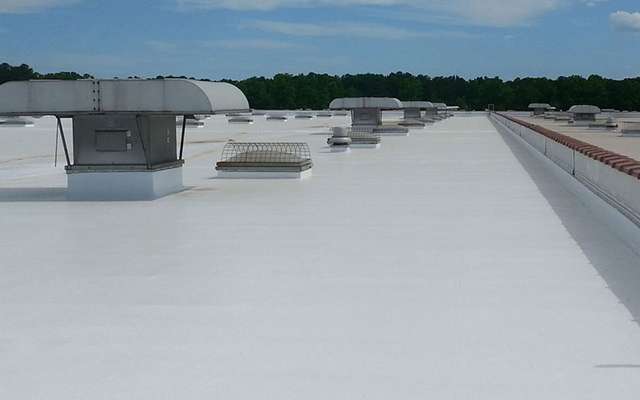Flat roofs are prone to leaking and can lead to significant property damage. Most building owners understand the importance of detecting roof leaks early, but many don’t know the most accurate testing method. Below, we’re going to discuss two common types of flat roof leak detection, the strengths, and weaknesses of each, and why using both may lead to the best results.
What is Electronic Leak Detection?
Electronic leak detection (ELD) is a process in which a technician uses a probe or brush to pass an electrical current to the roof membrane, sometimes through a very shallow layer of water. When there is a breach in the waterproofing membrane, the electrical current will flow through that hole or slice and travel to the steel or concrete decking, completing the circuit. When this occurs, the technology utilized will allow us to mark the exact location of the breach with pinpoint accuracy.
What is IR Moisture Detection?
Infrared (IR) moisture detection is a scan of a roof to determine damaged (wet) areas of insulation and the extent of the leak. As the roof sits in the sun all day, it absorbs heat, which naturally dissipates later in the afternoon or evening. Wet construction material beneath a leak will release heat at a significantly slower rate as the waterproofing membrane cools much quicker.
IR scanning can determine damaged areas beneath your roof membrane by indicating wet portions that release heat for more extended periods.
Why It’s Beneficial to Do Both
Both of these tests can reveal damage in different ways. ELD can pinpoint a leak and show you exactly where your roof may need repair to prevent ongoing leaking. IR moisture detection will reveal how significant and widespread the damage is, which can help determine how extensive the repairs need to be.
Risk of Not Doing Both
These tests are most beneficial in conjunction with each other because each offers a critical piece of information about roof damage. IR moisture detection can inform you about how significant the leak is and how much damage needs to be repaired. However, it won’t tell you where the damage has occurred, so you may end up spending more on larger repairs than are needed.
ELD will give you a precise location of any leak, but you won’t know how much damage has been done. You will be given an exact point on the roof membrane that needs to be repaired, but you’ll need IR moisture detection to determine if repairs beneath the membrane are required.
Both detection methods are useful for determining where roof damage is located and how severe the damage is. As such, having both tests done together will give you the information you need to avoid overspending on repairs or neglecting to repair existing damages. When you’re ready to get the clearest picture of your roof’s integrity and any existing damage below the waterproof membrane, contact one of our highly trained professionals to schedule an inspection.

